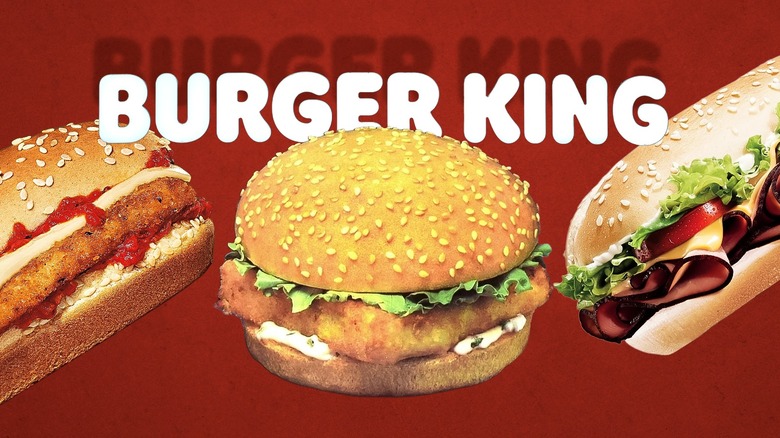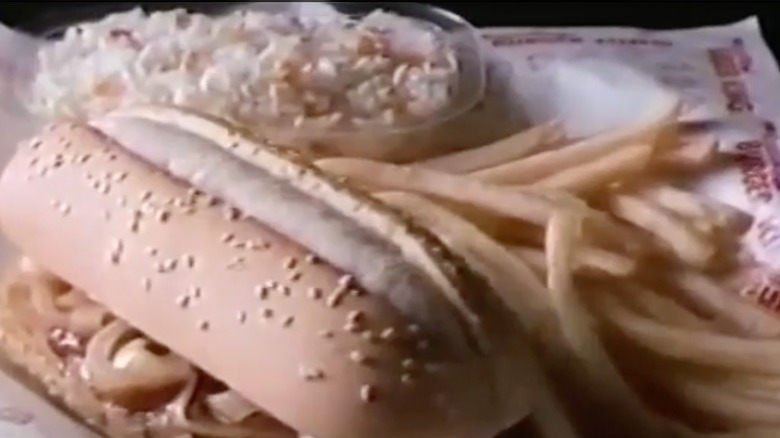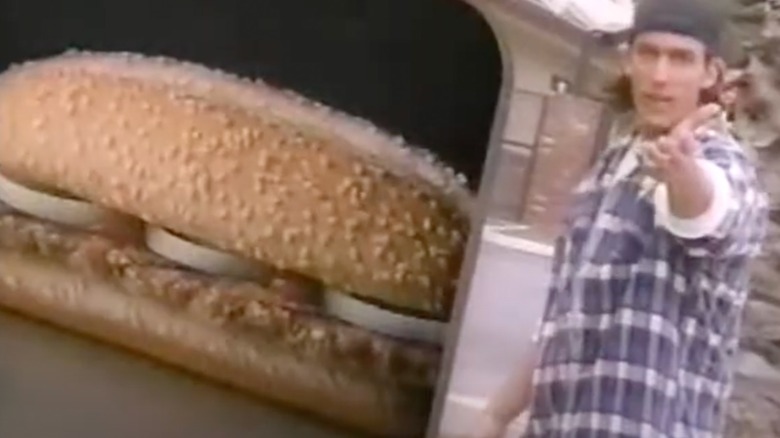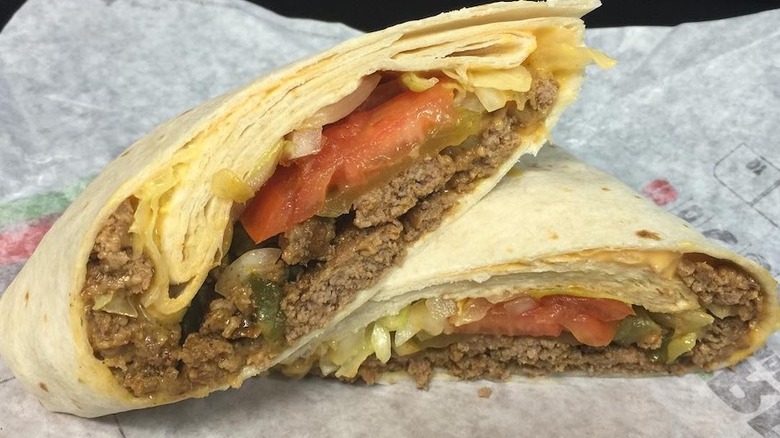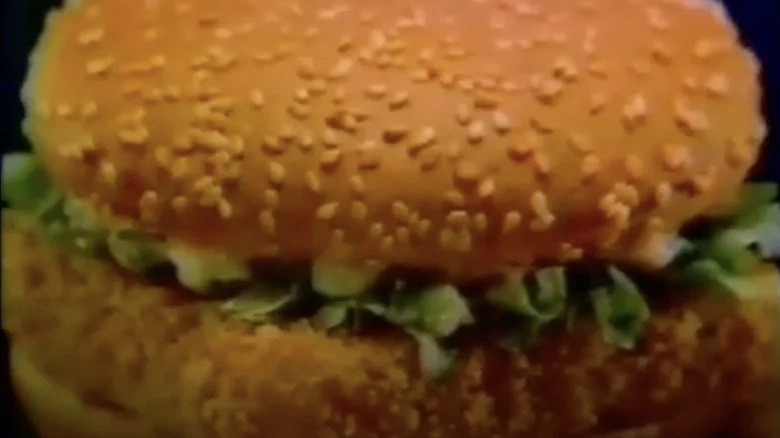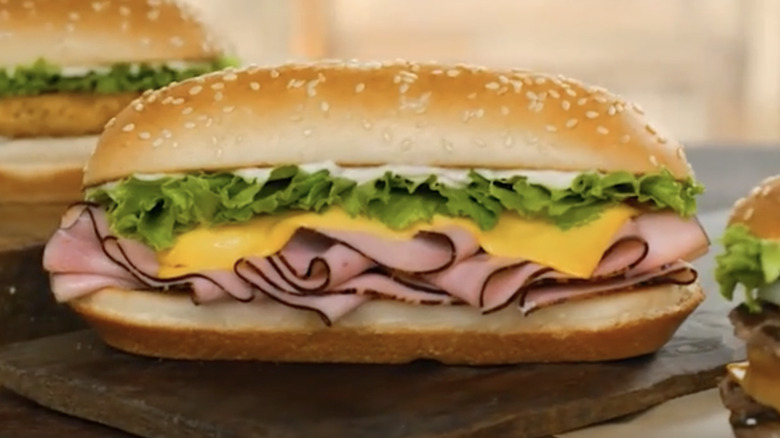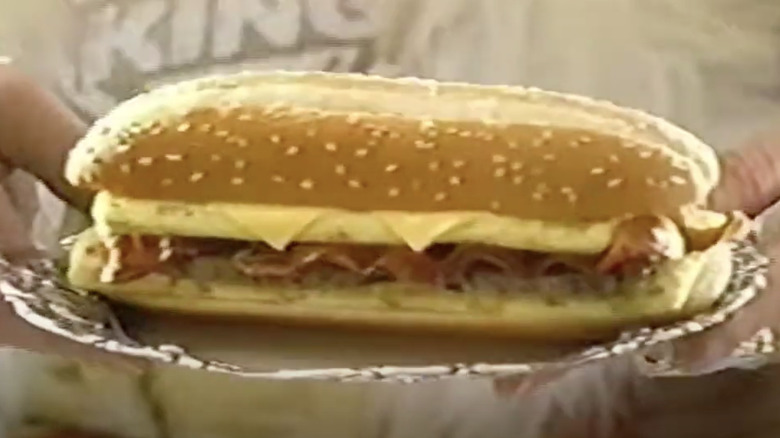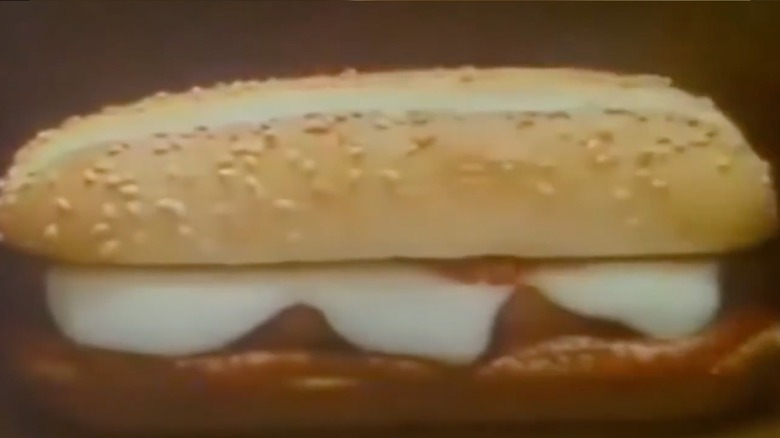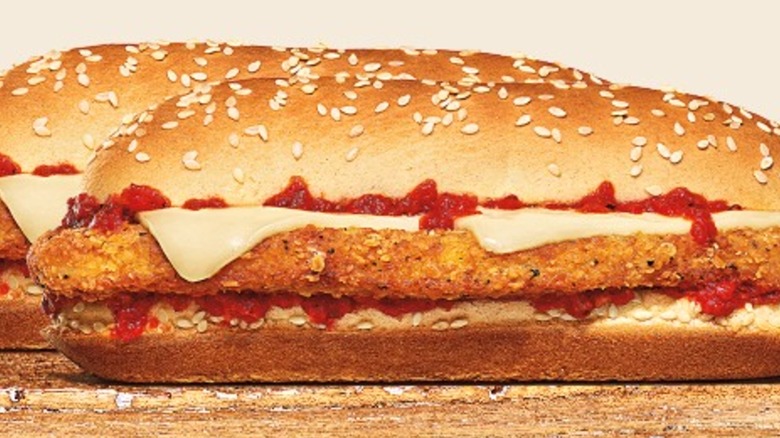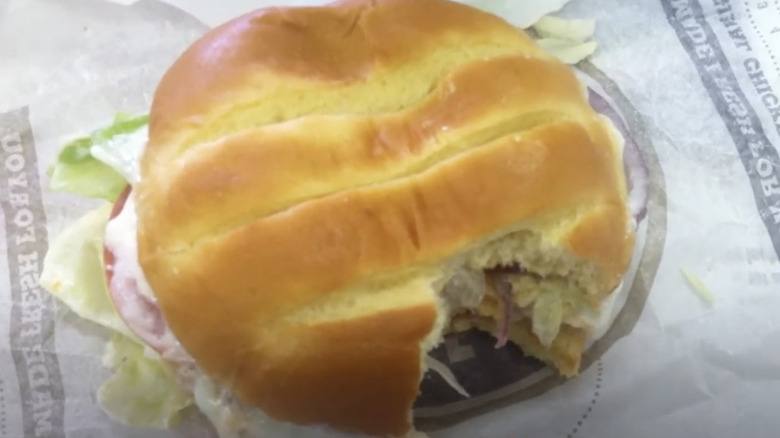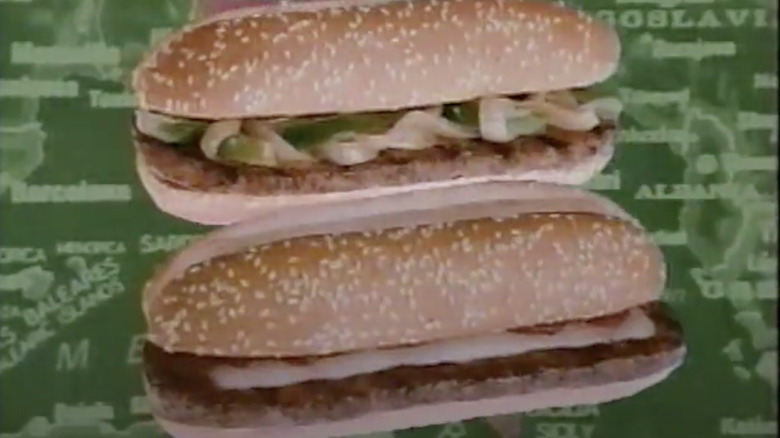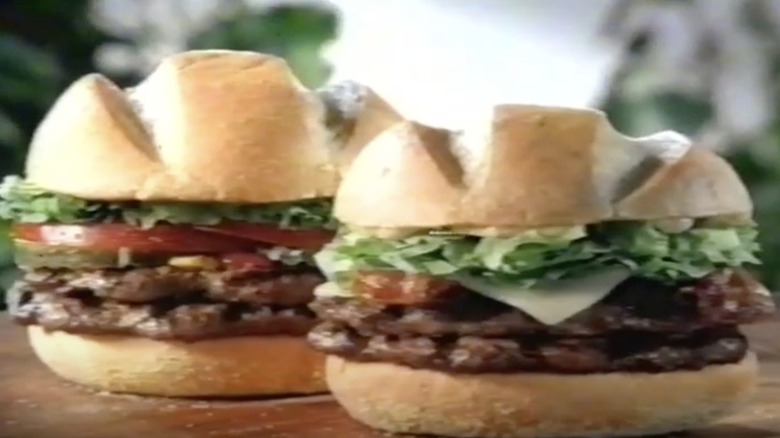Discontinued Burger King Sandwiches That Deserve A Comeback
Burger King is historically indisputably a fast food power player. Despite being one of the more mundane American burger chains, it sells more burgers than almost any fast food establishment, forever jockeying for position in the hearts, minds, and stomachs of fast food fans around the world with competitors like McDonald's and Wendy's. Still, Burger King is undeniable in a few ways: It's the place that brought the world the fire-cooked Whopper and the Original Chicken Sandwich, after all.
Among the things you should know about Burger King: The chain has almost exhaustively introduced new sandwiches throughout its lengthy history. Some have become instant classics and stuck around on the menu forever. Others came and went with little fanfare or even notice, and still more hit the Burger King menu, developed a devoted fanbase, and then were discontinued anyway. Here are the long since vanished Burger King burgers and sandwiches that fans still miss and might be deserving of a revival.
Steak sandwich
From 1992 to 1994, and only in the evening hours, Burger King transformed itself into a casual, sit-down restaurant for customers who were interested. They'd order at the counter and head to their table with a bowl of free popcorn while they'd wait for an employee to hand deliver one of Burger King's customizable dinner baskets. Customers got a roll, a green salad or coleslaw, a baked potato or fries, and an entree: fried shrimp, a breaded chicken fillet, a Whopper, or the brand-new Steak Sandwich. A fancier, longer cheeseburger with classier condiments, the Steak Sandwich consisted of a chopped and formed patty of beef inside of a sesame-seed bun and topped with lots of raw onions and a hefty amount of steak sauce.
Dinner baskets with numerous options of old and new items, as well as table service were both far outside the usual purview of Burger King, and neither concept lasted all that long. But it was an innovative attempt at broadening appeal and classing up the often mundane and no-frills world of fast food with an elevated hamburger that was simply ahead of its time.
Meatloaf sandwich
In 1993, Burger King added another entree option to its experimental evening table-side dinner baskets program which was also available a la carte throughout the day: the Meatloaf Sandwich. Marketed to older customers with an affinity for home-cooked, homestyle meals rather than the usual fast food cheeseburger, Burger King's take on the classic lunch made from leftovers of the previous night's dinner consisted of a flame-broiled patty of meatloaf (essentially a lengthy burger, but seasoned and bulked up to taste more like its inspiration) and condiments of raw onion rings and ketchup, that quintessential meatloaf topper.
Inspired by the dish made into an American staple during the Great Depression, Burger King's Meatloaf Sandwich with print and television ads, some of which featured the late baseball elder statesman and comic actor Bob Uecker. Despite modest acceptance of the sandwich, the company dropped the Meatloaf Sandwich in 1994 after incoming CEO Jim Adamson triggered a cost-saving menu scaling back that got rid of non-core items.
Whopperito
For a fast food conglomerate like Burger King, it's a cost effective measure to introduce a new menu item that makes use of the ingredients it already has in its kitchens. The Whopperito only required one, inexpensive new element: a tortilla. That's a thinking-outside-the-bun, sandwich-adjacent item introduced to Burger King's national menu in 2016, which served as a brand extension of, and thereby a promotion of, the chain's flagship big burger, the Whopper. The Whopperito's name is a portmanteau of Whopper and burrito, because the item itself was a combination of a Whopper and a burrito, in that it was all the stuff that came inside of a Whopper but rolled up inside a large flour tortilla rather than a hamburger bun. The wrap made use of chunks of seasoned, flame-broiled ground beef patties, lettuce, tomatoes, pickles, onions, and instead of sliced American cheese, a pour of nacho-style cheese sauce.
Critics couldn't make much sense of the Whopperito, or why it existed, especially since the tortilla used was far too large to house all of the ingredients, which amounted to less than what comes standard in a regular Whopper. Still, the Whopperito was an innovative way to get that distinctive Whopper taste in the form of a snack or portable sandwich way easier to eat than the messy and sloppy original burger. A change.org petition in 2021 to "Bring Back the Whopperito" failed to reach a signature benchmark, and the item never returned to Burger King.
The Whaler
Fast food went nationwide in the 1950s on the back of burgers and fries. In the 1960s, fast food diversified with KFC and Arby's popularizing chicken and roast beef, and McDonald's launching the Filet-O-Fish. Following the rise of fish-only restaurants like Arthur Treacher's Fish and Chips and Long John Silver's, Burger King decided to go for a swim in 1971 with The Whaler. It was essentially a clone of its competitor's Filet-O-Fish — a boneless, breaded, and fried whitefish patty on a bun — but with a supposedly superior tartar sauce and the addition of leafy lettuce. While fish sold well elsewhere in fast food, it didn't at Burger King; the Whaler disappeared from the national menu sometime in the 1970s.
But customer demand wound back around to where Burger King brought back the Whaler in 1983, albeit in a new-and-improved version. Ads claimed that it tasted better than its McDonald's counterpart, and offered as much food as a burger could. Burger King kept messing with the Whaler over the decades, at one point discontinuing the sandwich entirely and creating a new sandwich called the Ocean Catch, and then the Big Fish. It's said to be made from high quality pollock breaded in premium panko, and adorned with lettuce, pickles, and tartar sauce on a sweet brioche bun — a good sandwich, but very different from the original Whaler.
Yumbo
One of the first times Burger King ventured away from hamburgers, it was with the Yumbo Sandwich. Introduced in 1968, it was a simple ham and cheese sandwich, the former cut thin and the latter all melted and luscious, inside of a warm roll. A beef alternative that brought non-burger fans into Burger King, the chain kept it on the menu until 1974.
But those who'd had a Yumbo never forgot about the Yumbo, and it was apparently one of the most requested Burger King discontinued items for decades after its disappearance. In 2014, adopting a marketing plan centered around nostalgia that embraced '70s imagery and iconography, the Yumbo Sandwich made its much-heralded comeback to Burger King. The Yumbo was a little bit different, with mayonnaise and lettuce added to bulk up the ham and cheese, but it was still a welcome revival. But the new Yumbo was never supposed to last, and after a few weeks of availability, the limited-time-only sandwich vanished once more.
Ch'King
The chicken sandwich wars of recent years pitted dominant poultry chains Popeyes and Chick-fil-A against each other. So much attention and revenue was generated that the chicken sandwich wars entered a new era in 2021 when the big burger chains got involved, unveiling next-generation sandwiches designed to pull dollars and focus. For Burger King, it was a towering concoction called the Ch'King. Developed over the course of two years, the Ch'King presented a heavily breaded and extremely crispy chicken breast (like Popeyes' headline-making sandwich) in a large potato bun accompanied by a special sauce and pickle slices (similar to Chick-fil-A's regular chicken sandwich).
Burger King got exactly the response from the public it hoped for — the Ch'King earned excellent reviews from fast food critics, and seemingly sold well nationwide. And then, to the chagrin of the new sandwich's instantly amassed army of fans, Burger King pulled the Ch'King. Sales weren't through the roof, or at least not at a level that could justify the tremendous amount of time and labor it took to create the Ch'King: one sandwich was the result of a 21-step process.
Enormous omelet sandwich
America's eating trends are cyclical, and in 2004 and 2005 programs like the South Beach Diet and the Atkins Diet enjoyed a revival. Both plans emphasize consuming less carbs in favor of more protein and fat, respectively, and fast food chains responded with options that adhered to those diets. They didn't sell very well across the board, and in 2005, Burger King reversed course, going after the customers that market research indicated they should pursue: those who wanted sandwiches as big and as filling as possible. That philosophy was exemplified by a breakfast sandwich that packed more calories and fat than even the Whopper hamburger.
The appropriately named Enormous Omelet Sandwich was served on the extra-long buns used for Burger King's Original Chicken Sandwich. It included an omelet made from two whole eggs along with two pieces of processed cheese, a sausage patty, and three slices of bacon. The Enormous Omelet Sandwich had 730 calories and 47 grams of fat and was credited for Burger King's 20% sales increase during breakfast hours. After an outcry from nutrition experts, Burger King stopped selling the enormously popular Enormous Omelet Sandwich.
Veal parmigiana
Veal is a form of beef, the only difference being the age of the cattle source. Veal possesses an exceptionally tender texture and a more nuanced but velvety taste, owing to how the cows used are under the age of six months old who were pulled from their mothers just after they were born. Animal rights activists and many people who otherwise eat meat reject eating veal as an act of cruelty, which is why Burger King had a controversy on its hands in 1980 when it unveiled the Veal Parmigiana sandwich.
Presented as a specialty sandwich, the Veal Parmigiana was served on a long bun and included a tender veal patty slathered in tomato sauce and topped with mozzarella cheese. After the sandwich performed well in test markets, it made the regular Burger King menu and sold moderately until sales plummeted by 85% after a coordinated anti-Veal Parmigiana protest effort by more than 50 animal rights groups. The inventive but scandalous sandwich was discontinued in 1983.
Italian original chicken sandwich
The industry-leading, fan favorite Original Chicken Sandwich first showed up at Burger King menus across the country in 1979. In retrospect, it seems basic and ordinary, but at the time it was original indeed to put a boneless, chopped and formed chicken patty on a lengthy hoagie roll. But it was also built in a way that encouraged expansion and interpretation, and Burger King has created many spinoff dishes over the years, including the Italian Original Chicken Sandwich. Emulating and approximating a chicken Parmesan sub from a deli or Italian restaurant, the sandwich took a long chicken patty and put mozzarella cheese and tomato sauce on top of it.
Sold off and on throughout the 1990s and beyond, the Italian Original Chicken Sandwich quietly exited the Burger King menu in 2014, only to make a triumphant comeback in 2021 for a "two for $6" sandwich promotion. In spite of fierce attention from the media, Burger King's take on chicken Parm hasn't been back since that short period.
Turkey burger
In the spring of 2013, Burger King launched a promotion it called "Burger Fest." In the ambitious and ramshackle marketing event ostensibly designed to celebrate and sell meat patties on a bun, the chain rolled out nine new items, very few of which were actually traditional burgers. Apart from a bunch of drinks, sides, smoothies, a cheese-stuffed burger, a spicy Whopper variant, some chicken items, and one of its many vegetarian sandwiches, the star of the bunch was the straightforwardly named and prepared Turkey Burger.
Put forth as a healthier option than its calorie-packed and fat-drenched regular-menu fare of fried chicken sandwiches and giant cheeseburgers, the Turkey Burger was made out of a patty of low-fat, high-protein poultry on a special, artisan-style bun served warm. Even the condiments were healthier: just a little bit of mayonnaise along with tomatoes, lettuce, and red onion slices. The Turkey Burger was the first ever mainstream fast food turkey burger, and while it was well received, it didn't much outlast "Burger Fest."
Italian sausage sandwich
There are a lot of extinct fast food hot dogs, and Burger King is among the fast food chains that have served some of the highest quality hot dogs in the past, as well as similar products built around well-seasoned ground pork extruded into tubes. In 1992, Burger King introduced one of the first-ever sausage sandwiches offered outside of breakfast hours with the Italian Sausage Sandwich. With a foundation of a split sesame seed-studded bun, Burger King workers placed a spicy and flavorful split Italian sausage cooked under the flame broiler. It was dressed in one of two ways, to the customer's preference: with grilled onions and green peppers, or with mozzarella and marinara sauce.
An initial run of the sandwich was so successful that Burger King revived the limited-time offering almost immediately, making it an option in its table-side dinner basket program in 1993. It hasn't made an appearance on the menu since.
Back porch grillers
In 2002, just before Burger King was purchased in a private equity buyout by TPG Capital, the fast food mega-chain took a big swing with one of its biggest and most expensive new product launches in its history. Burger King allocated $80 million, and aligned itself with the rollout of the blockbuster film "Men in Black II," to debut a line of Back Porch Grillers. "We went back to our roots — the Burger King flame-broiled heritage — to create burgers that taste like the burgers people grill at home when they have time," Burger King CEO and president John Dasburg told QSR. Back Porch Grillers were prepared with a proprietary seasoning mix of a new, extra-thick patty, and served on a bakery bun along with lettuce, tomatoes, mustard, ketchup, and pickles for the BK Homestyle Griller, and with smoked real cheddar cheese, bacon, and barbecue sauce for the BK Smokehouse Cheddar Griller.
Burger King promised at the launch that Back Porch Grillers would be forever fixtures on the menu, but it stopped offering them after just four months. Sales of the burgers fueled a 15% growth in sales, but franchisees hated making them. Only about 8% of Burger King locations had the equipment necessary to grill the new, bigger patties, and the ones that didn't used two thinner patties. Not quite getting the product advertised, not a lot of Back Porch Grillers customers repeated their purchase.
BK stacker
When a hamburger chain introduces a new product, there's only so much they can do to enhance or improve upon a burger to where it's still recognizable as a burger and remain attractive to customers. Companies like Burger King tend to just pile more ingredients on the top of the patty, but in 2006, the chain went the other way, simplifying the burger-ordering process into its basic components. The BK Stacker wasn't one sandwich, it was many sandwiches, or a modular system of burger building. Every version of the BK Stacker rejected vegetables entirely, consisting of bun, burger, cheese, and bacon. Based on appetite or want, customers ordered a BK Stacker in single, double, triple, or quadruple variants, with each successive style adding additional beef, cheese, and bacon.
Burger King advertised the BK Stacker as a heroic and loud voice in a building backlash to an industry-wide healthy eating fad, seeking to capture customers with big appetites who didn't care much about fat or calorie counting and just wanted lots of beefy, cheesy, bacon-y flavor. "It's the flame-broiled meat lovers' burger, and it's here to stay — no veggies allowed," proclaimed one ad (per the New York Times). But that wasn't to remain true: Burger King cut down the BK Stacker in 2012.
